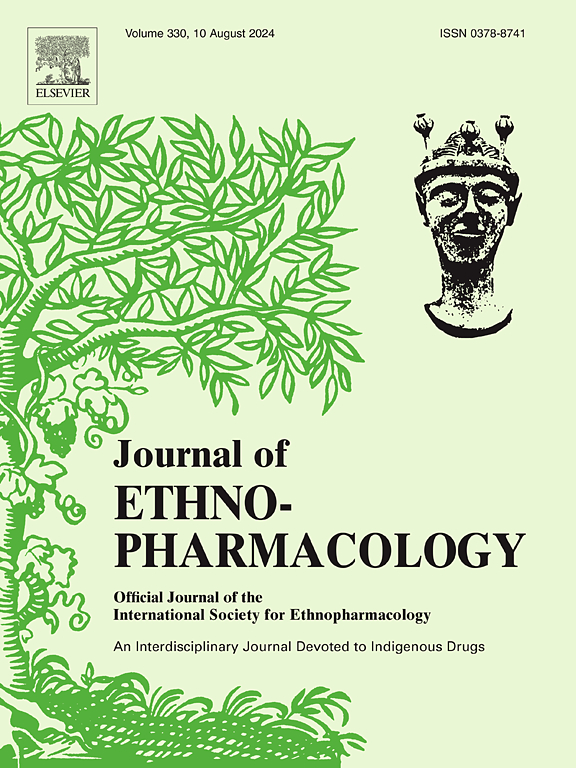Exploring the pro-angiogenic potential of Chinese herbal medicines: a comprehensive insight into mechanisms
IF 4.8
2区 医学
Q1 CHEMISTRY, MEDICINAL
引用次数: 0
Abstract
Ethnopharmacological relevance
Pro-angiogenic therapy aims to stimulate the formation of new blood vessels, thereby enhancing blood flow to tissues and organs. Current strategies, such as growth factors, gene therapy, and cell-based approaches, are widely employed to promote angiogenesis. However, these interventions often suffer from off-target effects and limited efficacy due to the complex regulation of angiogenesis. Chinese herbal medicine (CHM) provides a rich source of therapeutic agents and offers promising alternatives for the treatment of vascular insufficiency-related disorders.
Aim of the study
This review aims to summarise current research on the pro-angiogenic effects and underlying molecular mechanisms of CHM, including herbal extracts, traditional formulations and key bioactive phytochemicals.
Methods
A comprehensive literature search was conducted using electronic databases, including PubMed, Web of Science, and Google Scholar, covering publications from 2003 to 2024. Keywords including “Pro-angiogenic”, “Angiogenesis”, “Phytochemicals”, “Traditional Chinese Medicine”, “Natural compounds”, “Phytomedicine”, “Plant medicine”, “Botanical drugs” and “Chinese herbal medicine” were used to retrieve relevant studies. The retrieved articles were then assessed, summarised and synthesized to provide a comprehensive overview of the pro-angiogenic effects of CHMs and the molecular mechanisms underpinning these effects.
Results
We systematically summarised the key molecular mechanisms involved in angiogenesis, including the vascular endothelial growth factor (VEGF), notch signalling, angiopoietin-tie, fibroblast growth factor, platelet-derived growth factor and hypoxia-inducible factor (HIF) pathways. Mechanistically, CHMs exert pro-angiogenic effects through promoting cell survival, proliferation, and migration, primarily through the upregulation of VEGF, Notch signalling, MAPK signalling, HIF-1α, and PI3K- Protein Kinase B (Akt) signalling pathways.
Conclusion
Multiple Chinese herbal extracts, formulations and key phytochemicals demonstrate significant pro-angiogenic effects. The mechanisms of these effects are multifaceted. The evidence highlights the potential of CHMs as promising candidates for pro-angiogenic therapy, warranting the need for further research and development to fully harness their therapeutic value.

探索中草药的促血管生成潜能:全面了解其机制。
民族药理学相关性:促血管生成疗法旨在刺激新血管的形成,从而促进血液流向组织和器官。目前的策略,如生长因子、基因治疗和基于细胞的方法,被广泛用于促进血管生成。然而,由于血管生成的复杂调控,这些干预措施往往存在脱靶效应和有限的疗效。中草药为血管功能不全相关疾病的治疗提供了丰富的药物来源,并提供了有希望的替代方法。研究目的:本文综述了中草药的促血管生成作用及其分子机制的研究进展,包括中草药提取物、传统制剂和主要生物活性植物化学物质。方法:利用PubMed、Web of Science、谷歌Scholar等电子数据库,检索2003 - 2024年发表的文献。检索关键词为“促血管生成”、“血管生成”、“植物化学物质”、“中药”、“天然化合物”、“植物药物”、“植物药物”和“中草药”。然后对检索到的文章进行评估和总结。全面概述中药的促血管生成作用和支持这些作用的分子机制。结果:我们系统总结了血管生成的关键分子机制,包括血管内皮生长因子(VEGF)、notch信号、血管生成素、成纤维细胞生长因子、血小板衍生生长因子和缺氧诱导因子(HIF)途径。机制上,CHMs主要通过上调VEGF、Notch信号通路、MAPK信号通路、HIF-1α和PI3K-蛋白激酶B (Akt)信号通路,通过促进细胞存活、增殖和迁移发挥促血管生成作用。结论:多种中药提取物、制剂及关键植物化学物质具有显著的促血管生成作用。这些影响的机制是多方面的。这些证据强调了中草药作为促血管生成治疗的有希望的候选药物的潜力,保证了进一步研究和开发以充分利用其治疗价值的必要性。
本文章由计算机程序翻译,如有差异,请以英文原文为准。
求助全文
约1分钟内获得全文
求助全文
来源期刊

Journal of ethnopharmacology
医学-全科医学与补充医学
CiteScore
10.30
自引率
5.60%
发文量
967
审稿时长
77 days
期刊介绍:
The Journal of Ethnopharmacology is dedicated to the exchange of information and understandings about people''s use of plants, fungi, animals, microorganisms and minerals and their biological and pharmacological effects based on the principles established through international conventions. Early people confronted with illness and disease, discovered a wealth of useful therapeutic agents in the plant and animal kingdoms. The empirical knowledge of these medicinal substances and their toxic potential was passed on by oral tradition and sometimes recorded in herbals and other texts on materia medica. Many valuable drugs of today (e.g., atropine, ephedrine, tubocurarine, digoxin, reserpine) came into use through the study of indigenous remedies. Chemists continue to use plant-derived drugs (e.g., morphine, taxol, physostigmine, quinidine, emetine) as prototypes in their attempts to develop more effective and less toxic medicinals.
 求助内容:
求助内容: 应助结果提醒方式:
应助结果提醒方式:


